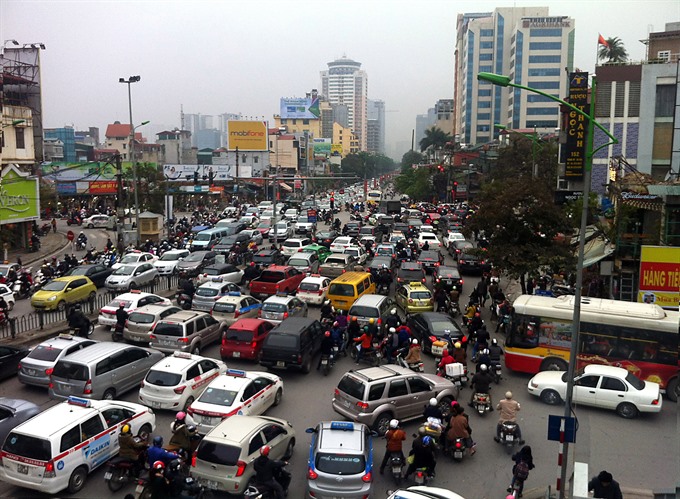 Society
Society

Last week, Hà Nội municipal authorities asked the Standing Committee of the National Assembly to consider a number of special financial mechanisms for infrastructure development of the capital city, arguing that current budget constraints prevent it from responding to an urban planning and transportation "debacle".
 |
| Traffic congestion at Giảng Võ – Láng Hạ - Đê La Thành intersection. Experts say that the paralysing traffic stress on the city has more to do with past and ongoing faults in urban planning and development, rather than lack of money. — VNA/VNS Photo Hoàng Hùng |
HÀ NỘI – Last week, Hà Nội municipal authorities asked the Standing Committee of the National Assembly to consider a number of special financial mechanisms for infrastructure development of the capital city, arguing that current budget constraints prevent it from responding to an urban planning and transportation "debacle".
Hoàng Trung Hải, Secretary of the Municipal Party, said the city had completed the planning for eight metro lines with a total length of 300km, but there had been no progress on implementing the project since investors deem it unattractive.
Nguyễn Đức Chung, Chairman of the municipal People’s Committee, requested that the sale of shares in state-owned enterprises – estimated at VNĐ50 trillion (US$2.2 billion) in the next five years – be given to Hà Nội to invest in its development projects. He also requested that the city be given more autonomy in large-scale projects.
However, many experts are of the opinion that the paralysing traffic stress on the city has more to do with past and ongoing faults in urban planning and development, rather than lack of money.
Disregard for planning
According to Dr Phạm Sỹ Liêm, former Deputy Minister of Construction, budget is an essential condition for the development of infrastructure. However, in the case of Hà Nội, the lack of funding is not the root cause of the chaotic traffic situation in recent years.
Liêm did not mince words, stating that the fault lies in insufficient oversight and poor management of key transportation projects over the past decade.
The case of the Trung Hoà–Nhân Chính urban area was cited as an example, since the number of high-rise buildings built there surpassed the limit allowed. Some apartment buildings were even built on lots designated specifically for parks and parking zones, which are already a scarcity in the sprawling city. In fact, Colonel Đào Vịnh Thắng, Chief of Hà Nội’s traffic police department, recently said that newly approved parking spaces only met 10 per cent of the car parking demand.
Questionable adjustments made to urban planning, without taking into consideration infrastructure capacity, had led to massive traffic congestion in Trung Hoà–Nhân Chính urban area.
Nearby this urban area, more than 20 high-rise apartment blocs lined Vũ Trọng Phụng Street, just 1km long and barely wide enough for two lanes, making congestion inevitable, Liêm said.
Similarly, numerous apartment buildings in the Linh Đàm urban area were two-three floors higher than permitted; one particular offender even exceeded the registered level by 10 floors to accommodate some 500 additional apartments. The fact that the investors could circumvent regulations this way was a clear indication of lax oversight, he said.
“If supervision is carried out properly, such rampant construction and disorderly urban centres would not be allowed,” he added.
Experts warned about the traffic snarls in the city a long time ago.
However, until 2015, Hà Nội municipal People’s Committee still approved new planning in inner city districts, giving the green light to a number of 45 to 50-floor apartment buildings to accentuate the city’s skyline.
“Nguyễn Trãi or Giảng Võ areas have for long been regarded as traffic bottlenecks as a result of a high population concentration and being on the path of many large-scale projects, such as the bus rapid transition (BRT) system or Cát Linh–Hà Đông overhead railway,” Liêm said.
In an effort to ease congestion and infrastructure stress, city authorities drew up plans to move factories and manufacturers out to the suburbs. But the plans were undermined when authorities approved requests by development moguls to build urban complexes right on the “reclaimed land lots” in Giảng Võ and Thanh Xuân areas – putting further strains on transportation infrastructure.
“The authorities allowed numerous apartment buildings to squeeze themselves into the already cramped inner city areas, that’s why even a generous budget will not help Hà Nội resolve the overcrowded and overloaded situation it is facing,” Liêm asserted.
In addition, many key transportation projects are running behind schedule, resulting in heightened traffic jams and incurring cost overruns of thousands of billions of đồng.
These delays reflect the weak supervision capacity of the projects’ management boards, according to experts.
The BRT system, overhead railway, or subway, are all being implemented in Việt Nam for the first time. Therefore, if domestic supervisors prove to be wanting in qualifications, the city’s authorities have to hire foreign supervisors in their place.
The hiring will certainly be expensive, but that is easily outweighed by the reduced risks of delays and cost overruns.
Building heights
Professor Đặng Hùng Võ, former Minister of Natural Resources & Environment, echoed Phạm Sỹ Liêm’s opinion on the leading cause of current traffic chaos in the capital city, pinning the blame on poorly conceived planning modifications without relying on scientific research and assessments or taking into consideration the capacity of existing transportation infrastructure.
“With the urbanisation at break-neck speed since the beginning of the millennium, Hà Nội authorities foresaw the risks of traffic overload and devised a number of viable urban plans – including parking spaces for the period 2003-2020,” Võ said. “But, the reality is that large swathes of land originally reserved for transportation projects were transformed into apartment buildings or shopping malls, instead,” he added.
Regarding urban areas, Võ claimed most investors committed various violations, flouting original planning, especially by construction of more floors than permitted.
Recently, Hà Nội authorities issued new regulations on height management applied to buildings being constructed in the inner city’s historic areas, including many high-rises in crowded residential areas with dense traffic.
Võ cautioned that if planning is devised haphazardly without taking into account the maximum load that infrastructure can sustain, it would be really difficult to deal with undesirable consequences down the road.
Lưu Bình Nhưỡng, a member of the Standing Committee for Social Issues under the National Assembly, summed it up thus: “The problem with Hà Nội is not lack of budget, but lack of vision on planning and management.” – VNS




